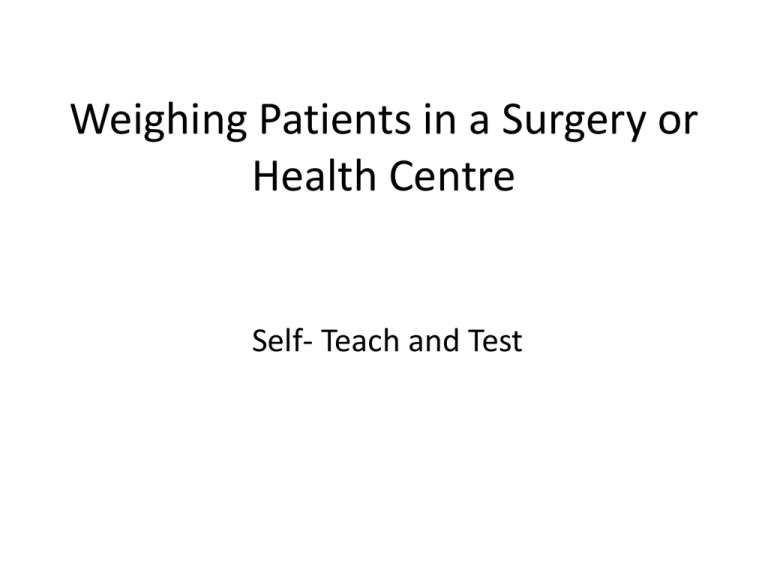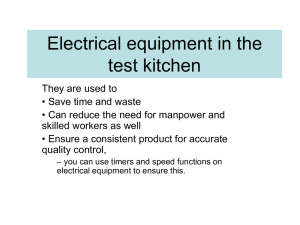Weighing Patients for diagnostic purposes Self teach and test
advertisement

Weighing Patients in a Surgery or Health Centre Self- Teach and Test Background • Scales used for medical purposes became subject of regulation in 2003 • It includes all scales used for the determination of mass in the practice of medicine for weighing patients for the purpose of monitoring, diagnosis and medical treatment • Project carried out in 2010-12 to determine how many scales complied with the regulations Medical Weighing project • Number of areas for improvement in the use of scales by medical practitioners • Only 23% of surgeries trained staff in the use of scales • This self teach presentation designed to assist with this issue Intended outcomes At the end you will; • Understand the need for accurate weighing of patients • Recognise appropriate equipment to be used for the purpose • Know basic good weighing practice • Know where to seek advice if you need it in future Basic Principles • Scales should be considered as scientific, diagnostic equipment similar to thermometers or blood pressure machines • They must be used appropriately • On a firm level flat surface • Nothing should be leaning against them Basic principles • Use only on solid floors, not on carpets and babyweighers should be on a firm shake free bench • If the scale has a level “bubble”, make sure the “bubble” is in the centre of the ring Basic Principles • Some non-electronic scales have a steelyard with moving poises, which the operator uses to determine the weight of the patient. The correct weight is achieved either by the steelyard being level, or by it hitting the “up” stop or the “down” stop. If you use this type of scale, you need to check the correct operation first. Basic Principles • The patient should be stood, sat or laid on the scale and should be still when the reading is taken, they should not be supported or held in any way • Try to minimise the amount of clothing worn which all counts towards the apparent weight of the patient and remove shoes. • The indication should be at rest or stable when the reading is taken. Basic Principles • If standing, the patients’ feet should be squarely and completely on the platform with the patient standing upright. • If sitting on a chair scale, both feet must be on the footrests (not the floor!) and hands on the hand rests. • If lying on the scales, position the patient centrally and ensure any overhanging limbs are not bearing down on any other surface Basic Principles • Baby weighers need special attention – it is hard to make a baby stay still • Likewise an unco-operative adult may also be difficult • You need patience with these patients! Basic Principles • The scale must show zero. Electronic Scales must be zeroed before they are used • If using a hoist scale, the sling must first be placed empty on the hook and the machine zeroed before the patient is sat upon it. • If the patient is being weighed in a wheelchair, either weigh the wheelchair first, or if there is a “tare” button place the empty wheelchair on the scale; zero, then reweigh with the patient in the wheelchair. The Technical Bit • Scales used for Diagnostic assessment are subject to regulations • The manufacturers have to have them approved before they put them on sale • You can tell if the scales are of the correct type if they have the marks on them on the following page Approval marks The first three should be present at all times on the scale This one, with the red star, means the equipment has been put out of use The Bottom one means it has been repaired and put back into use Approval Marks on a data plate Data plates and digital readings • Scales should have a data plate which gives a serial number and an approval number • It will give the maximum weight the scales are suitable for and the scale division size – which determines how accurate the readings you take are. • Digital scales give discrete readings in steps, rather than a continuous reading that is displayed on a chart or pointer scale, a scale division of 50g, means that the true weight is within +/- 25g for the reading. Scale division sizes the right level of accuracy for the right patient Adults Young Children Babies Checking weight for records 500g 200g 50g Regular monitoring to assess weight change 200g 100g 10/20g Measuring weight to assist medical diagnosis 200g 50/100g 10/20g Measuring weight for critical treatment e.g. dialysis 50/100g 20/50g 5g Recording birth weight 20g Measuring weight before and after breast feeding 10g Reasons not to use Bathroom Scales • Fine for domestic use • Not suitable for medical use: • Not sufficiently accurate • Not good enough quality • Following slides show why.... Reasons not to use Bathroom scales • They have a dual chart of imperial and metric indications • The metric indication is hard to read, likely to use the imperial chart • Drugs are administered in metric • Extra calculation to calculate the metric equivalent. • You can only read to the nearest kilogramme. Reasons not to use Bathroom scales The same person standing on the same set of bathroom scales- here he weighs 71 kg Whilst here, simply by standing further back on the platform he weighs 74 kg. This difference means you do not know the true weight. Reasons not to use Bathroom scales for medical analysis • The reading on the scale is difficult to read and can only be estimated to the nearest kg. The reading is actually 14kg • The true weight of the patient – 15.34kg that is 1.3 kg out which equates to 8.5% error! • This “patient” is 5 yrs old Reasons not to use Bathroom scales for medical analysis • This small person appears to weigh 10kg • Whereas in fact the true weight is 11.02 kg. That is a 9% error. This follows, as the smaller the patient, the greater the inaccuracy will be. This “patient” is 2 years old. Reasons not to use Bathroom scales for medical analysis To summarise; • They are generally of poor quality and often inaccurate • They can be hard to read truthfully • They can vary with the persons standing position • They are totally unsuitable for children • They are illegal Deciding on the right scales for my workplace • Source scales from a manufacturer who specialises in medical scales. • Catalogues and advice can be found on the internet – help is available from the UK Weighing Federation • There are standard types suitable for most purposes in a surgery, but also an array of specialist equipment:- Deciding on the right scales for my workplace – do we need any of the types below? Deciding on the right scales for my workplace - types • Do I need a sit on or stand on type? • What age will the patients be? The requirements for children are more stringent than for adults • What is the weight of the largest person it will be used for? • Do I need a hoist type? • How accurate does the reading need to be? Self test for Practice Managers Have I Got the message? • Does my surgery have suitable and legal equipment sited in the right places? • Have the staff using them been trained in their proper use? • Do we have an inventory and a regular test regime to ensure scales remain correct? Self test for practitioners • Have I got access to scales where I need them? • Are they of the correct maximum capacity and scale division size for my patients? • Are they on a hard level surface? • Do they have the correct markings to show they are of the correct type? • Do I always make sure they show zero when unloaded before I use them? • Do I ensure the patient is still when I take my reading?








